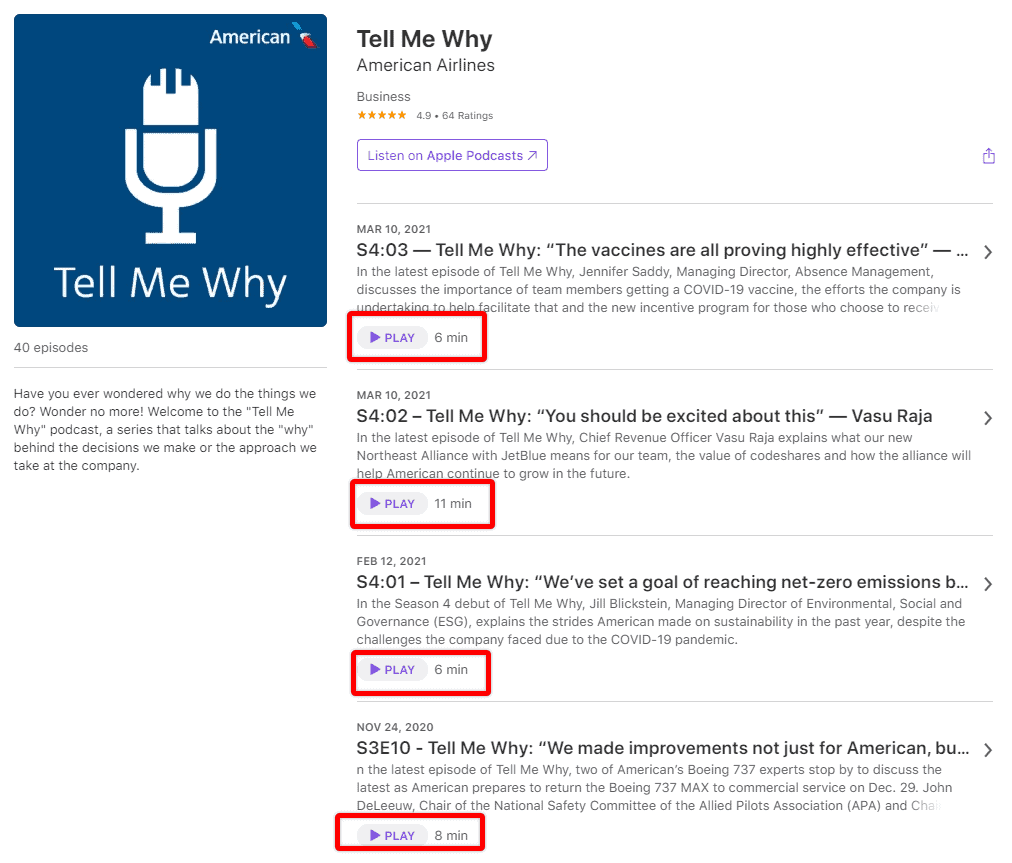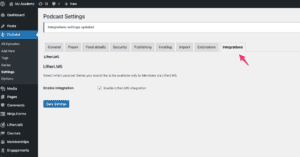Employers are turning to podcasts to communicate with their people because other methods of communication have grown stale and outdated. No one wants to read another email or join their company’s private Facebook group. No one has the mental space for another Slack channel. This is organizations are turning to the employee communication podcast.
“If you ask any internal communications team, the biggest problem isn’t producing content, it’s getting anyone to pay attention to it,” says James Ellis, a branding and recruitment consultant, keynote speaker, and podcaster. “Intranets are never visited, emails are never read and employers are desperate for new ways to generate traction with employees.”
According to the Wall Street Journal, about 30 companies in the S&P 500 have developed an employee communication podcast, including Verizon, Caterpillar, Home Depot, Netflix, Apple, and American Airlines. These companies recognize the power of audio to communicate news, stories, and information with their teams.
In this article, we’d like to offer some advice on developing and launching your own employee communication podcast.
Action
Read to start your own podcast? Learn the nitty-gritty details of starting your own show in our comprehensive guide. Learn how to start a podcast.
10 Employee Communication Podcast Tips
Publishing an employee podcast is similar to a public show, but with a few exceptions. We recommend reading our full guide on how to start a podcast. Then dive into these employee podcast tips.
1. Start with a Clear Purpose
Before you start producing episodes, it’s important to declare a purpose and define some goals. Assign a metric to each goal to measure your progress. This will help you understand whether your employee communication podcast is a success or a failure.
“I’ll just measure my downloads,” you’re probably thinking. Downloads are not a metric. That’s an output. It’s great to have lots of downloads, but that number won’t tell you if your employee communication podcast is serving its purpose.
Let’s say you want your podcast to keep everyone in your organization informed about company news. You could give them a survey before publishing your first episode that asks them how informed they feel. Then give them the same survey after you release 10 episodes to see if that number has changed.
2. Put Some Money Behind It
Well it’s true that starting a podcast requires very little investment, it’s best to give your employee communication podcast a small budget. This will ensure that your show has enough production value to make your team interested.
For instance, you’ll need to buy some basic podcasting gear, but especially a microphone. It’s also smart to pay for a transcription service to turn your audio content into written content or anyone who prefers that format.
If you aren’t comfortable editing audio files, you’ll definitely want to pay someone to handle that for you. Audio quality will make or break the success of your show, so it’s important to get this component right.
3. Work with a Podcast Hosting Service
You’ll need somewhere to upload your episode files, but your company’s web hosting service is not a good solution for this. Web hosts are not optimized for audio files.
Instead, work with a podcast hosting service that has all the features you need. Here are some reasons you should choose Castos to host your employee communication podcast:
- Remarkably easy platform with powerful features.
- You can either install our WordPress plugin, Seriously Simple Podcasting, and add a new podcast from your WordPress backend (just like adding a new page or post), or upload new episodes directly to your Castos dashboard.
- Unlimited storage and episodes.
- Generous download limits on all pricing tiers.
- Import all of your existing podcast content with one click.
- Get your episode automatically transcribed.
- Automatically republish your content to YouTube.
- Access advanced analytics about your listeners.
- Plans start at $19 per month.
- All come with unlimited storage and episodes.
- 14-day free trial.
4. Consider a Limited Series
If you aren’t ready to commit to regular episodes, consider producing a limited series that you can plan all once. This is a smaller commitment, kind of like a TV pilot, that gives you the opportunity to gauge everyone’s reaction. Aim for six or eight episodes. If everything goes well, you can commit to a weekly or monthly episode.
5. Select an Engaging Host
It may be an employee communication podcast, but people still expect to be entertained. You don’t need to hire a veteran podcast host, but you should select somebody from your company with charisma and a bit of showmanship.
When you look for a host, search beyond the leadership team that everyone recognizes. Don’t be afraid to look through all of your ranks. Depending on the size of your company, you may even find some people who have experience in podcasting.
6. Keep it Short and Simple
If you expect your team to use their personal time to listen to work-related content, it’s important to keep your episodes short. No one is going to volunteer an hour of their evening to engage with their job. If you expect them to listen to it at work, it’s still important to keep your episodes short, otherwise you’ll lose productive time. Some of the best employee podcasts are 20 to 30 minutes.

How do you keep an episode short? By getting to the point quickly. Cut out all the fluff. Give them the big information or news right away. Don’t string them along with unnecessary teasers or frustrating buildup. Limit yourself to no more than two speakers per episode. Most importantly, stick to the show’s narrative from beginning to end. Don’t jump around multiple topics or your listeners won’t understand what it’s about.
This also means keeping the format of your show simple. Use something people understand, like the interview format, the solo/monologue podcast format, or the co-hosted podcast format. Dynamic formats like panel discussions and non-fictional storytelling are probably too complex for employee communication podcasts.
7. Be Honest and Genuine
An employee communication podcast seems like one of those situations where you should be super corporate, but that approach fails to excite anyone. Avoid trying to play it safe.
Compose episodes that are genuine and authentic. Tap into the real employee experience. Don’t be afraid to address issues you know you should work on or challenges the company is struggling with. If you pretend everything is perfect all of the time, you’ll just sound fake and out of touch.
7. Share Personal Stories of Real People
“People are attracted to stories,” says Keith Quesenberry, a research partner at Johns Hopkins, “because we’re social creatures and we relate to other people.” It’s in our nature to value stories more than cold advice or data.
Share the stories of real people who work in your organization. Invite them on to your employee communication podcast if you can. Help them organize their tale into a story-like structure to create a great episode. Here are some ideas of what you could ask them about:
- How their home life affects their work
- How they set and achieved a goal
- A challenge they had with the company and got it solved
- What an event or trip was like
8. Decide Whether it will be Public or Private
Most podcasts are public, but depending on the type of content you intend to publish, you may decide to set your employee communication podcast as private. Private podcast episodes can only be downloaded by the people who have access. In this case, your employees.
Private podcasts are still available on all the popular podcast directories (like Apple Podcasts, Google Podcasts, Stitcher and Spotify), but only to those who you’ve awarded access. These kinds of shows are good ways to keep information within your organization.


When you start a podcast with Castos, you can choose to set your show as public or private. When you add your private subscribers by email (which should be easy because you can just copy your employee email list), Castos will send an email on your behalf inviting them to your private podcast. They subscribe with a unique RSS feed URL to their favorite podcasting app. Castos’ Private Podcasting is included in all of our standard pricing plans.
9. Plan Your Episodes in Advance
Once you start publishing episodes, it’s best to release on a set schedule. That schedule can be anything you like, but try to stay consistent so that the employees know when to expect more content. Consistency also helps keep you on track and avoid podfading.
To stay consistent, you’ll need to plan your episodes in advance. Give yourself plenty of time to organize your thoughts and create notes or write a script. If you plan to host interviews, keep in mind that your guests have schedules too, so give them plenty of notice.
10. Make it Available
Our final tip for launching an employee communication podcast is to promote your show throughout your organization. Don’t expect your people to find it on their own
One of the great advantages to an employee podcast is that your potential audience is clearly defined. Your show is designed for a specific group of people and you have ways of contacting all of them. You could meet with your entire audience one-on-one to tell them about the new podcast if you wanted to (though we don’t recommend this method – it’s a bit pushy).
How should you promote your show?
- Email the company newsletter when new episodes are released.
- Announce new episodes in your Slack or Teams channels.
- Enlist the help of team leaders or company influencers to promote for you.
- Plug the show at events or big meetings.
- Distribute memos and other print materials throughout the workspace.
Good Luck with Your Employee Communication Podcast
These tips will help you launch and grow your employee communication podcast. Like all endeavours, you won’t get everything right at the beginning. Stick with it and improve little by little over time. Eventually you’ll create a show your team loves.
Have you ever built an employee communication podcast? Leave your tips in the comments.





We have just started a private employee podcast at our company – with great success! All colleagues absolutely enjoy this new communication strategy. Every week the staff can’t wait for the next episode to be released.
My tips for successful implementation:
– Courage to invest: For a successful implementation you need professional equipment as well as a promising basic concept.
– Podcast is entertainment: Always ask yourself how you can meaningfully combine important information with humorous elements.
– Not too long, not too short: Orientate your timing to the average journey to and from work. We have had good experience with an average of 25 minutes